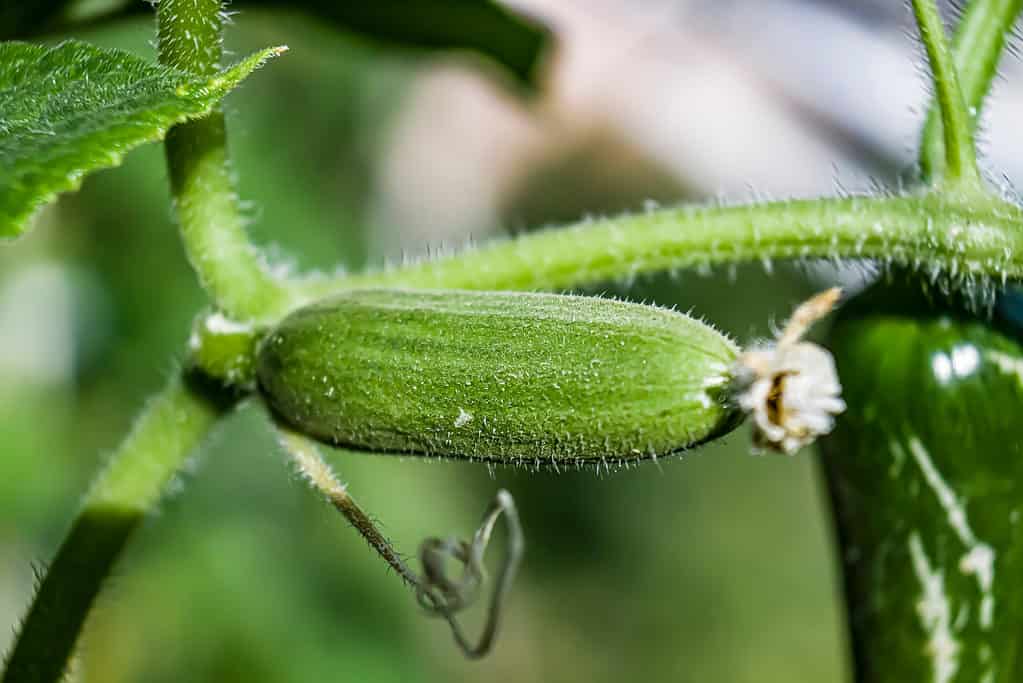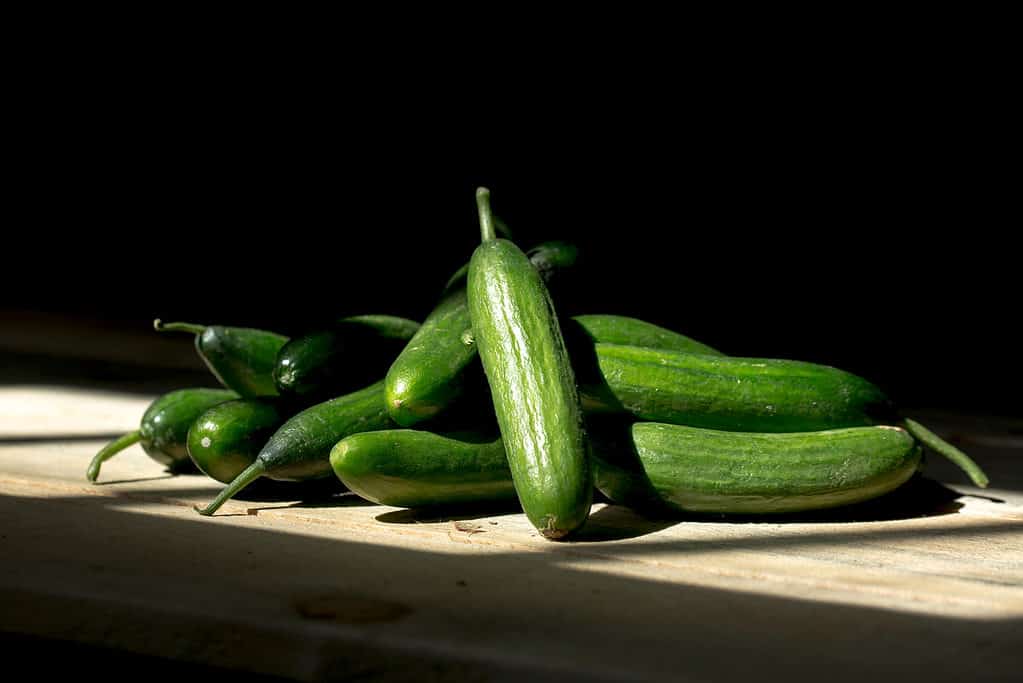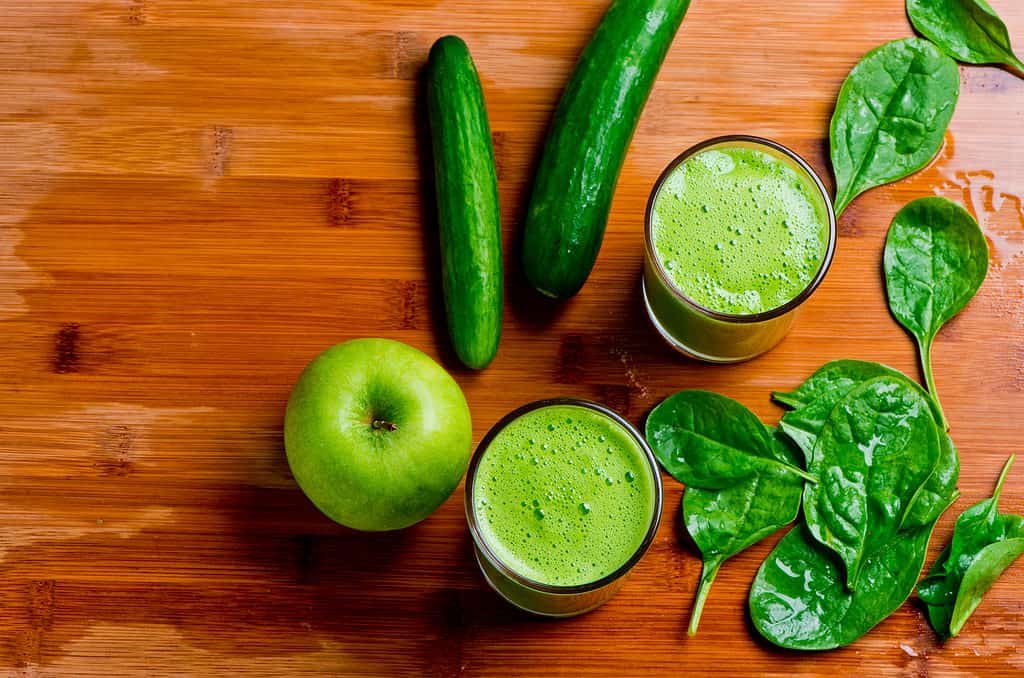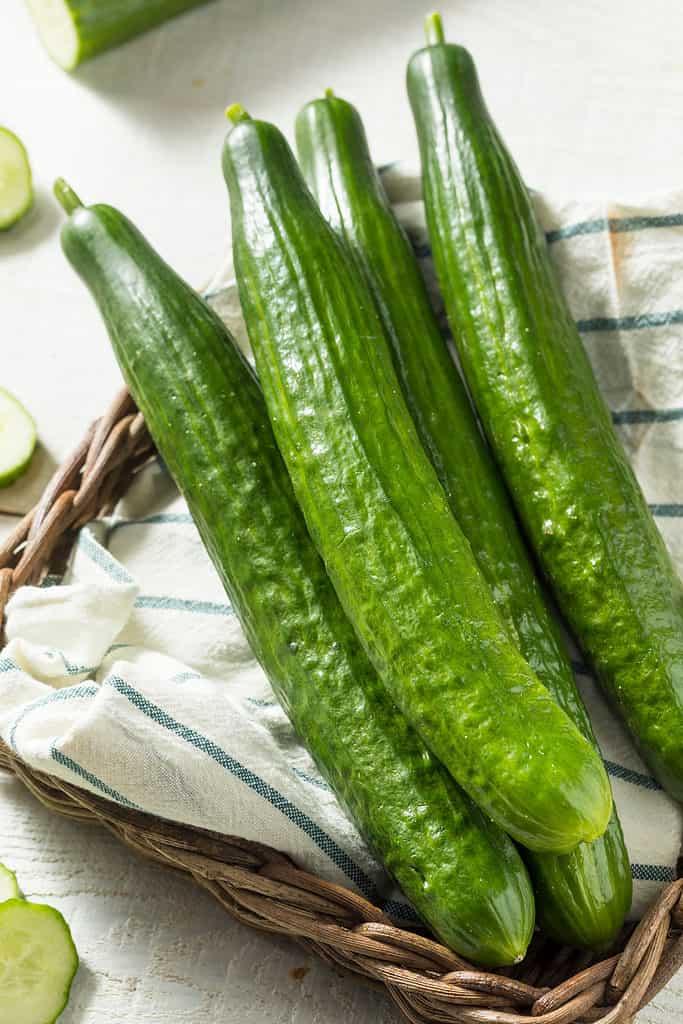If you’ve ever walked into the grocery store and noticed that there are a few different cucumber varieties available, you’ve likely seen Persian cucumbers and English cucumbers side by side. The two fruits are similar enough most of us don’t think about the differences between Persian cucumbers vs. English cucumbers, though, unless we’re asked about it.
One variety is nearly seedless, while the other is smaller and often has a more “rugged” appearance to it. There’s a reason for that, as both have been hybridized and produced with intent.
Let’s check out the differences and see which one you might want to bring home to plant.
| Persian Cucumber | English Cucumber | |
|---|---|---|
| Classification | Cucumis sativus L.; numerous varieties | Cucumis sativus; countless varieties |
| Description | Persian cucumbers are smaller, rounder cucumbers with pale green flesh, tiny, thin seeds, thin green skin in emerald to dark green, and smooth or ridged skin. | English cucumbers are elongated, cylindrical fruits that typically grow to 14 inches in length, with tapered ends. The fruit is sweeter than other cucumbers and is nearly seedless. |
| Uses | Persian cucumbers are used largely in salads, as pickles, in raw dishes, and cooked dishes, and provide many valuable nutrients the human body needs, such as fiber, water, and Vitamin C. | English cucumbers are nearly seedless, so they are used in sushi and similar dishes that are best prepared without seeds. They also provide folks with many nutrients such as Vitamin K, protein, and Magnesium. |
| Origins and growing preferences | Persian cucumbers originated as a small variety of cucumbers hybridized by European settlers in the northern Israel region of Beit Alpha, trying to reduce disease weakness in the plant. They need full sun and warm temperatures to thrive and may be grown in aeroponic or hydroponic systems or soilless media. | English cucumbers originated in India and Western Asia and date back as far as the Old Testament. They should be planted in full sun in warm climates. |
| Special features and fun facts | China produces nearly 76% of the world’s supply of cucumbers and gherkins, which are 95% water, and super low in calories. | Cucumbers are believed to have ultra sanitizing properties – with claims that if you hold a raw cucumber slice to the inside roof of your mouth for 30 seconds, you’ll kill bacteria in the mouth. |

English cucumber is used for many different kinds of dishes.
©iStock.com/bhofack2
Key Differences Between Persian Cucumber and English Cucumber
These two similar cucumber types are useful for many of the same things, but there are definitely some differences.
Persian Cucumber vs. English Cucumber: Classification

Cucumbers grow on vines like other melon species.
©Vladimir Konstantinov/Shutterstock.com
Botanically classified as Cucumis sativus L., Persian cucumbers are a small type of cucumber you can find easily at most grocery stores in the United States. The vegetable is part of the Cucurbitaceae family and is designated as an improved class of cucumbers, with higher quality flavor, texture, and disease resistance. Persian cucumbers are vining plants that come in many varieties, including the most common: Figaro, Cordito, Picolino, Katrina, Ishtar, Iznik, Manar, and Socrates. Persian cucumber is a blanket term used for these small cucumbers coming from the northern Israel region. They are also referred to generically as gherkins.
English cucumbers or European cucumbers are a variety of nearly seedless cucumber in the same family as the Persian cucumber, the Cucurbitaceae family. The plant is known scientifically as Cucumis sativus (minus the L.). This type of cucumber is longer and slimmer than the gherkin or Persian cucumber. The skin on this variety of cucumber is also tender and nonwaxy. English or European cucumber is a broad term used loosely for these long, slender, nonwaxy, nearly seedless or fully seedless cucumbers. There are numerous varieties of English cucumbers.
Cucumbers are technically a melon (fruit) or gourd and are somewhat related to watermelon, squash, and similar plants.
Persian Cucumber vs. English Cucumber: Description

Fresh cucumber may have ridged or smooth skin, depending on the variety within the plant species.
©depoo/Shutterstock.com
Persian cucumbers, or gherkins, are easily identified as the smaller, rounder cylindrical cucumbers often found in grocery stores. The fruit (yes, technically not a vegetable) is smaller in size than other varieties of cucumber, coming in at 4 to 6 inches in length when fully grown. These cucumbers may be either straight or slightly curved, with thin skin that is emerald to dark green and tender. The skin may be either smooth or have shallow ridges. Beneath the skin, the fruit it pale green, dense, and firm, with succulent texture. The fruit contains pale green seeds that are soft and edible and typically go unnoticed when eaten. The fruit has a mild, sweet, vegetal flavor that leaves no noticeable aftertaste.
English cucumbers are part of the same family, though the fruit looks a little different. The plant in both cases is a creeping vine that may either climb or sprawl, with roots in the ground and large leaves that canopy over the fruit. English cucumbers are elongated, cylindrical fruits with tapered ends, with the fruit often growing as long as a foot, though some have been seen at 2 feet or slightly longer. They appear proportionately narrower than Persian cucumbers. English cucumbers are nearly seedless, with a mild, vegetal flavor that’s slightly sweeter than other cucumbers. English cucumbers also tend to be straight, with little to no curve. The skin is usually thinner than other cucumbers and is rarely peeled.
Persian Cucumber vs. English Cucumber: Uses

Cucumbers are used in salads and cooked dishes, as well as smoothies.
©Marie Sonmez Photography/Shutterstock.com
Persian cucumbers are mildly flavored fruits, more commonly used as vegetables, thanks to their vegetal taste. They are mild and sweet and suited well to fresh use in raw salads, sides, and eaten plain, as well as certain kinds of cooking or preserving. Persian cucumbers are the smaller fruits in the cucumber genus and are often referred to as gherkins. If you know anything about gherkins, you know they’re often turned into pickles. Typically, Persian cucumbers are used in fresh green salads, onion and cucumber salads, fresh tacos, added to dressings and salsas, added to grain bowls, used in roasted meat dishes, curries, and rice-based dishes. They are also often used as a fresh (uncooked) pizza topping, served in cold soups, and added to dips and sauces like Tzatziki.
English cucumbers are used much in the same ways as Persian cucumbers. However, since they are nearly seedless and the skins are so thin and rarely peeled off, they are used for sushi and similar dishes as well, in which seeds are cumbersome and less favorable. They are also frequently used in tea sandwiches known as cucumber tea sandwiches, as well, and in vegan spring rolls. They are longer and larger around than Persian cucumbers, so they make for excellent slicing cucumbers and are often added to crudite platters.
Cucumbers over all provide many health benefits. They are low in calories but packed with vitamins and minerals and other nutrients, including fiber, protein, Vitamin C, Vitamin K, Magnesium, Potassium, and Manganese. They contain antioxidants which help build the immune system and help the body fight off chronic conditions, they promote hydration since they are largely made up of water, and some believe they help promote and aid in fat loss. Some medical studies have shown that cucumbers may help lower blood sugar and promote regularity. And being so easy to add into the diet, they are favored by many who struggle to eat enough fruits and vegetables on a regular basis.
Persian Cucumber vs. English Cucumber: Origins and Growing Preferences

A young English cucumber plant
©Siam SK/Shutterstock.com
If you’ve ever heard of a Beit Alpha type cucumber, you’re learning about Persian cucumbers. The reason this type of cucumber is known as a Beit Alpha is because it originated in the Beit Alpha region of northern Israel. Some believe the cucumber’s specific origins began in the 1930s, when a small variety of cucumbers was developed through the planting by European socialists settled into a kibbutz in Israel. When the species’ vulnerability to disease became known in the area, they began breeding the cucumber with other varieties of cucumbers from Japan, Surinam, the United States, and India to weed out the weakness. Eventually, the cucumber became stronger and then became popular in the Middle East where it was called the Lebanese cucumber.
To grow your own Persian cucumbers, you’ll want to plant seeds a half-inch deep, with 18 to 24 inches between them, in soil that’s safe from frost. The seeds will germinate when the soil hits between 80 and 90 degrees Fahrenheit, so most folks start the plants indoors on a heat mat. They thrive in summer climates between 65 and 90 degrees Fahrenheit, in Zones 4 to 11, though they do best in Zones 5 to 9. They need full sun and will only tolerate partial shade if absolutely necessary. If they’re indoors, provide them with full spectrum LED lights and some heat. Persian cucumbers also make for excellent soilless plants, growing among rock wool and coco pellet media and hydroponic and aeroponic systems.
The English cucumber is believed to actually be native to India and Western Asia, with historical records suggesting they have been cultivated for human consumption for the past 3,000 years, with mention as far as the book of Numbers in the Old Testament. It is believed that the cucumber was introduced to Europe by exploring Romans, with evidence of plants as early as the 800s in France, 1300s in England, and 1500s in North America.
English cucumbers need to be planted where they will receive at least 6 hours of full sun every day. They thrive in raised beds and containers, as well as traditional in-ground gardens. They should be planted in soils that have been amended with peat and compost, or sand if the soil is compact. They need to have decent drainage to prevent root rot. Plant seeds between 6 and 8 inches apart, with rows about 2 feet apart.
All cucumbers need to be grown with others of the same species nearby, as they have both male and female flowers that need cross pollination.
Persian Cucumber vs. English Cucumber: Special Features and Fun Facts

Cucumbers need little preparation for eating: cut off the stem and wash as needed.
©Brent Hofacker/Shutterstock.com
If you’ve ever heard the term “burpless” in reference to cucumbers, it’s referring to the fact that some species of cucumbers cause belching. A burpless variety does not, and these are typically seedless varieties as it is the seeds that cause the belching issues. These varieties are also usually sweeter than other cucumbers and have thinner skin.
China produces something like 75% of the world’s gherkins and cucumbers. Raw cucumbers are 95% water, which makes them super low in calories, most being only 16 calories for an entire cucumber. In Northern England, pickles are sometimes called wallies. Emperor Tiberius of ancient Roman demanded a cucumber on his table daily, year-round and the reason is that cucumbers have high disinfectant (and therefore healing and protective) qualities to them. If you hold a cucumber to the roof of your mouth for at least 30 seconds, it can help kill bacteria there. And you can rub cucumber slices on noisy hinges to lubricate them naturally and avoid using chemicals.
Next Up:
- English Cucumber vs. Cucumber: Is There a Difference?
- Gherkin vs. Cucumber: Is There a Difference?
- Why Are Cats Scared of Cucumbers?
- Is Cucumber a Fruit or Vegetable?
The photo featured at the top of this post is © Brent Hofacker/Shutterstock.com
Sources
- Specialty Produce, Available here: https://specialtyproduce.com/produce/Persian_Cucumbers_9121.php
- Phytotheca Knowledge Base, Available here: http://www.phytotheca.com/phytotheca/cucumber-persian-baby/
- Cabi, Available here: https://www.cabi.org/isc/datasheet/16967
- Wikipedia, Available here: https://en.wikipedia.org/wiki/European_cucumber
- New World Encyclopedia, Available here: https://www.newworldencyclopedia.org/entry/cucumber
- Earth Food and Fire, Available here: https://www.earthfoodandfire.com/how-to-grow-english-cucumbers/
- Mr. Plant Geek, Available here: https://mrplantgeek.com/2017/06/03/20-cool-facts-about-the-cucumber/
- Healthline, Available here: https://www.healthline.com/nutrition/7-health-benefits-of-cucumber
Thank you for reading! Have some feedback for us? Contact the AZ Animals editorial team.






